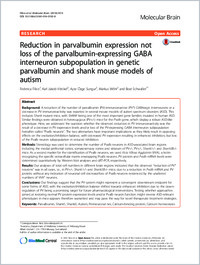Reduction in parvalbumin expression not loss of the parvalbumin-expressing GABA interneuron subpopulation in genetic parvalbumin and shank mouse models of autism
- Filice, Federica Anatomy, Department of Medicine, University of Fribourg, Switzerland
- Vörckel, Karl Jakob Behavioral Neuroscience, Faculty of Psychology, Philipps-University of Marburg, Germany
- Sungur, Ayse Özge Behavioral Neuroscience, Faculty of Psychology, Philipps-University of Marburg, Germany
- Wöhr, Markus Behavioral Neuroscience, Faculty of Psychology, Philipps-University of Marburg, Germany
- Schwaller, Beat Anatomy, Department of Medicine, University of Fribourg, Switzerland
-
27.01.2016
Published in:
- Molecular Brain. - 2016, vol. 9, p. 10
English
Background A reduction of the number of parvalbumin (PV)-immunoreactive (PV⁺) GABAergic interneurons or a decrease in PV immunoreactivity was reported in several mouse models of autism spectrum disorders (ASD). This includes Shank mutant mice, with SHANK being one of the most important gene families mutated in human ASD. Similar findings were obtained in heterozygous (PV+/-) mice for the Pvalb gene, which display a robust ASD-like phenotype. Here, we addressed the question whether the observed reduction in PV immunoreactivity was the result of a decrease in PV expression levels and/or loss of the PV-expressing GABA interneuron subpopulation hereafter called “Pvalb neurons”. The two alternatives have important implications as they likely result in opposing effects on the excitation/inhibition balance, with decreased PV expression resulting in enhanced inhibition, but loss of the Pvalb neuron subpopulation in reduced inhibition.Methods Stereology was used to determine the number of Pvalb neurons in ASD-associated brain regions including the medial prefrontal cortex, somatosensory cortex and striatum of PV-/-, PV+/-, Shank1-/- and Shank3B-/- mice. As a second marker for the identification of Pvalb neurons, we used Vicia Villosa Agglutinin (VVA), a lectin recognizing the specific extracellular matrix enwrapping Pvalb neurons. PV protein and Pvalb mRNA levels were determined quantitatively by Western blot analyses and qRT-PCR, respectively.Results Our analyses of total cell numbers in different brain regions indicated that the observed “reduction of PV⁺ neurons” was in all cases, i.e., in PV+/-, Shank1-/- and Shank3B-/- mice, due to a reduction in Pvalb mRNA and PV protein, without any indication of neuronal cell decrease/loss of Pvalb neurons evidenced by the unaltered numbers of VVA⁺ neurons.ConclusionsOur findings suggest that the PV system might represent a convergent downstream endpoint for some forms of ASD, with the excitation/inhibition balance shifted towards enhanced inhibition due to the down-regulation of PV being a promising target for future pharmacological interventions. Testing whether approaches aimed at restoring normal PV protein expression levels and/or Pvalb neuron function might reverse ASD-relevant phenotypes in mice appears therefore warranted and may pave the way for novel therapeutic treatment strategies.
- Faculty
- Faculté des sciences et de médecine
- Department
- Département de Médecine
- Language
-
- English
- Classification
- Biological sciences
- License
- License undefined
- Identifiers
-
- RERO DOC 258964
- DOI 10.1186/s13041-016-0192-8
- Persistent URL
- https://folia.unifr.ch/unifr/documents/304754
Statistics
Document views: 114
File downloads:
- sch_rpe.pdf: 252
